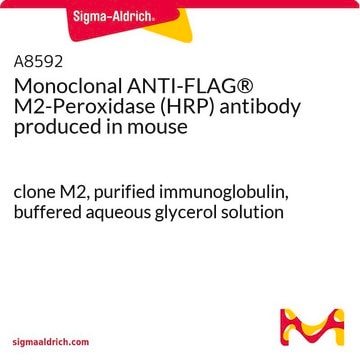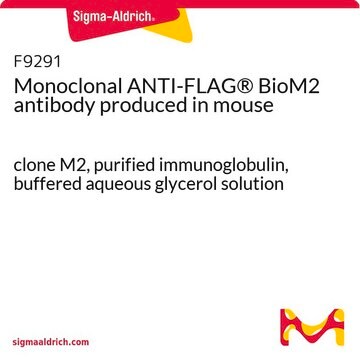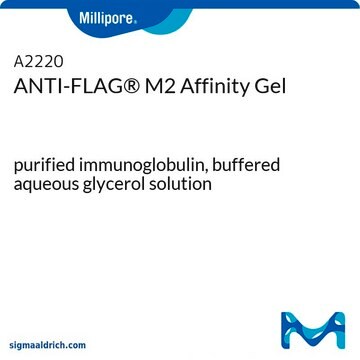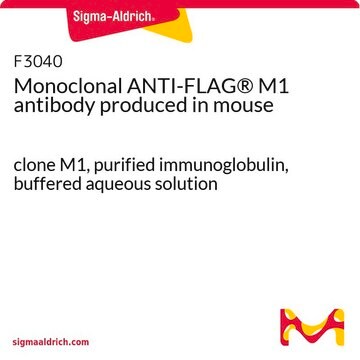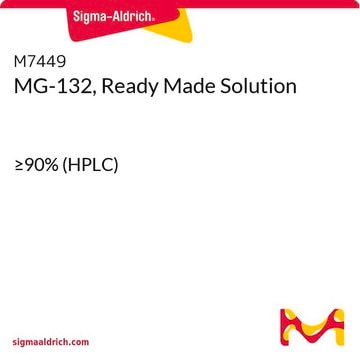Product A9594, Monoclonal ANTI-FLAG® M2-Cy3™ antibody produced in mice, is mouse IgG1. Theoretically, it will be recognized by the anti-mouse IgG secondary antibody. However, Product A9594 is already conjugated with Cy3 so a secondary antibody is not needed for detection.
Wichtige Dokumente
A9594
Monoklonales ANTI-FLAG®-M2-Cy3™ in Maus hergestellte Antikörper
clone M2, purified immunoglobulin, buffered aqueous solution (Supplied as a solution in 10 mM sodium phosphate)
Synonym(e):
Monoklonaler ANTI-FLAG® M2-Antikörper in Maus hergestellte Antikörper, Anti-ddddk, Anti-dykddddk
Größe auswählen
724,00 €
Größe auswählen
About This Item
724,00 €
Empfohlene Produkte
Biologische Quelle
mouse
Qualitätsniveau
Konjugat
CY3 conjugate
Antikörperform
purified immunoglobulin
Antikörper-Produkttyp
primary antibodies
Klon
M2, monoclonal
Form
buffered aqueous solution (Supplied as a solution in 10 mM sodium phosphate)
Speziesreaktivität
all
Konzentration
~1 mg/mL
Methode(n)
direct immunofluorescence: 10 μg/mL using mammalian cells fixed with methanol:acetone
Isotyp
IgG1
Immunogene Sequenz
DYKDDDDK
Versandbedingung
dry ice
Lagertemp.
−20°C
Suchen Sie nach ähnlichen Produkten? Aufrufen Leitfaden zum Produktvergleich
Verwandte Kategorien
Allgemeine Beschreibung
Anwendung
Western Blot (1 Publikation)
Weitere Produktinformationen finden Sie in unserem FLAG® Literatur-Portal .
Physikalische Form
Angaben zur Herstellung
Sonstige Hinweise
Rechtliche Hinweise
Sie haben nicht das passende Produkt gefunden?
Probieren Sie unser Produkt-Auswahlhilfe. aus.
Lagerklassenschlüssel
10 - Combustible liquids
Flammpunkt (°F)
Not applicable
Flammpunkt (°C)
Not applicable
Hier finden Sie alle aktuellen Versionen:
Analysenzertifikate (COA)
Die passende Version wird nicht angezeigt?
Wenn Sie eine bestimmte Version benötigen, können Sie anhand der Lot- oder Chargennummer nach einem spezifischen Zertifikat suchen.
Besitzen Sie dieses Produkt bereits?
In der Dokumentenbibliothek finden Sie die Dokumentation zu den Produkten, die Sie kürzlich erworben haben.
Kunden haben sich ebenfalls angesehen
-
A9594(FLAG M2 Cy3標識)の抗体は抗マウスIgGの2次抗体に認識されますか。
1 Antwort-
Hilfreich?
-
Aktive Filter
Unser Team von Wissenschaftlern verfügt über Erfahrung in allen Forschungsbereichen einschließlich Life Science, Materialwissenschaften, chemischer Synthese, Chromatographie, Analytik und vielen mehr..
Setzen Sie sich mit dem technischen Dienst in Verbindung.



